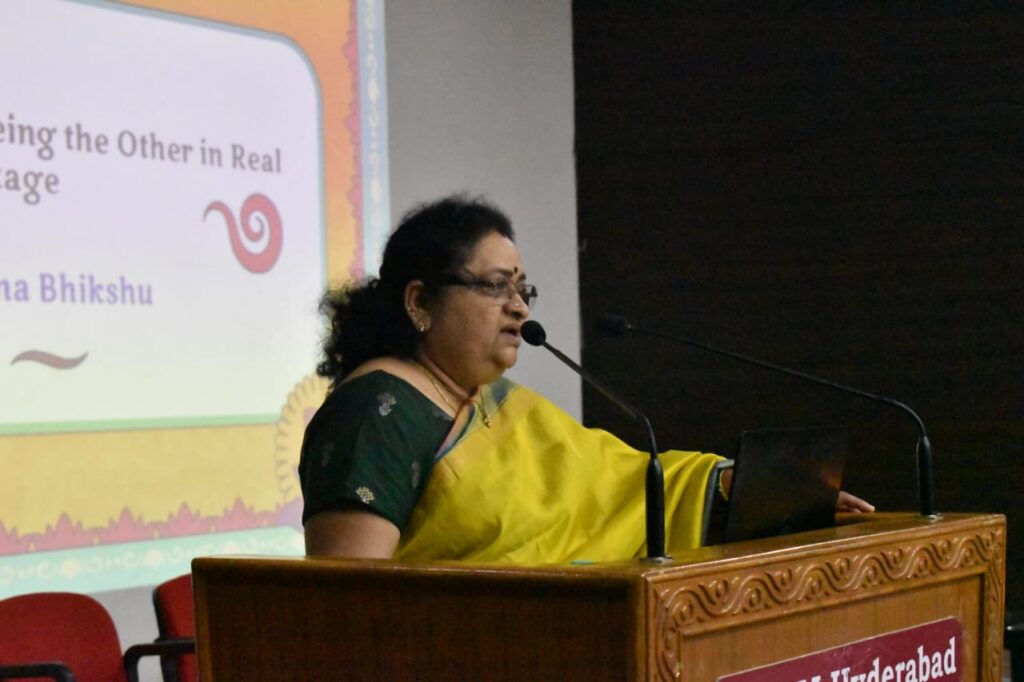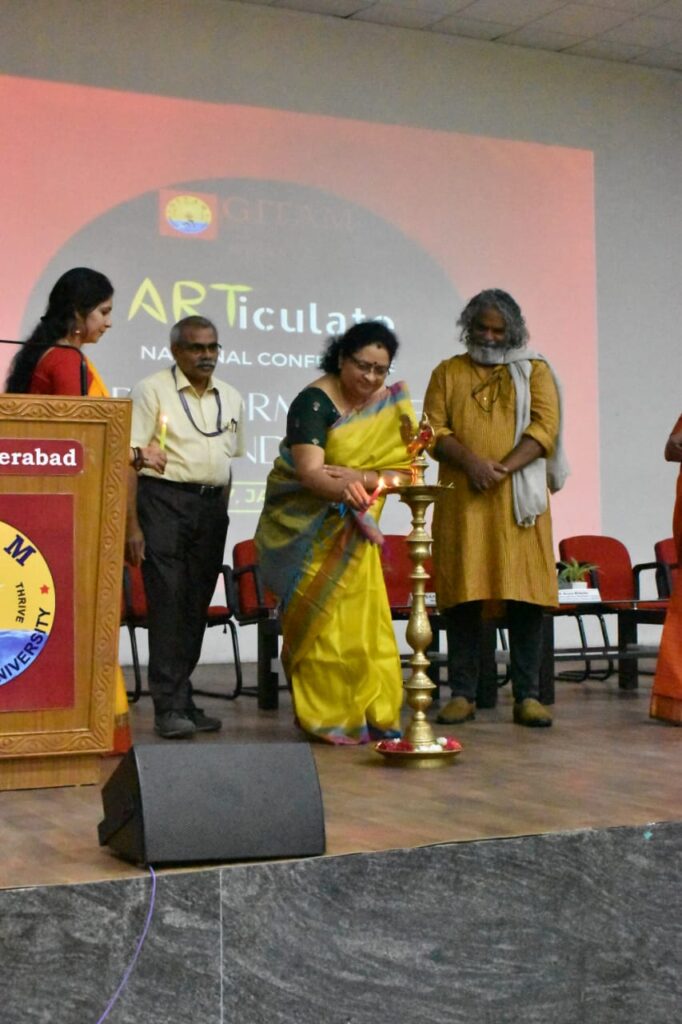Mohiniyattam dancer and Faculty at Gitam University, Dr. Mythili Maratt Anoop, setting the tone for the one-day national seminar, ‘ARTiculate 2023, Performative India’, which was held the day after Republic Day at the Gitam University Campus in Hyderabad, said that a catalogue of implications of ‘performance’ today includes a wide range of staged acts including social drama, concerts and theatrical performances, events of varied kinds, productions involving the various media, displays on streets, malls or public spaces, participatory events that challenge the audience and performer roles, or occurrences that blur the lines between reality and fiction.
She further said that the performing arts in India had been undergoing several changes since their renaissance in the early 21st century when they were recast as tokens of the cultural identity of the new nation. “Several traditional performing arts of India continue to sustain themselves through negotiating changed contexts, patronage patterns and audience expectations, while others recede into oblivion,” she said.
Delivering the key note address, noted Kuchipudi dancer, actor, and Professor, Dance Department, University of Hyderabad, Dr. Aruna Bhikshu reflected on the idea of performance, and the multiple ways in which everyone performs, dons a role and becomes a performer. She drew from Indian and Western theories of performance studies in articulating the notion of performance.

The paper presentation session began with Guntheti Naveen, Ph.D Research Scholar, Dept of Theatre Arts, University of Hyderabad, paper on the ‘Aesthetics of Koodiyattam Practice: Use of Rasa, Bhava, and the Creative Experience’, which was chaired by the director in- charge of the GITAM School of Humanities and Social Sciences, Dr. Chandrashekhar Deverakonda. After speaking about the origin of Koodiyattam, the scholar spoke about the its practice by the specific communities like the Chakyars and Nambiars. Naveen stated that the art form’s stylisation becomes possible through body movements, facial expressions, spoken verse, costumes, props, and other related aspects. In the Navarasa practice by G. Venu in Kerala, the scholar said that four different yet related factors have been given equal importance, which are physical, verbal, ornamental, and psychological. “Due to the involvement of these factors, acting acquires a new meaning than what is suggested by Western practitioners. Moreover, the presence of elements of ‘rasa’ and ‘bhava’ adds to the practice of the art form,” he said. The paper focuses on the different techniques and shades involved in the practice of Koodiyattam in the context of modern day, along with the researcher’s first-hand experience in Koodiyattam with Guru Rajaneesh Chakyar, and the Rasa Box with Dr. Abhilash Pillai. It also deals with how these techniques in Koodiyattam practice brings out artistic expressions and meaningful constructions of images.
Another Research Scholar from Department of Dance, University of Hyderabad, Sravya Bandaru presented a paper on ‘The Visual Documentation of Indian Classical Dances: A Case Study of National Cultural Bodies of India’. This paper discussed the practice of visual documentation happening at an institutional level – SNA, CCRT & IGNCA – in India, its evolution, and the significant concerns, such as – The rapid change in technology and the lacuna in the adoption and implementation of it into the visual documentation process; Obstacles around the ethical circulation of original works and carry forwarding the cultural values; Copyright infringement issues; Inaccessibility of the masters’ works to the researchers, practitioners, and performers.
Sravya said that addressing these concerns and analysing the role of digital media and technologies could further enhance and deploy solutions in creating broader scope for the people to access, pursue and preserve in the continuation of ICDs. “This would also supplement the process of visual documentation and further aid scientific studies. As video or audio recording was not preferred at the three organizations, the SNA, IGNCA, and CCRT, the answers and observations were recorded by note taking and later converted to detailed written documentation,” she said.

Urvashi Mohinani, Research Scholar from Department of Dance, University of Hyderabad, presenting her paper – ‘Classical Dance Education in Varanasi: Pedagogy, Practice and Performances’, online stated that Varanasi, Banaras or Kashi was addressed as the land of Lord Shiva and Nataraja, the Lord of Dance. She stated that Varanasi had been a major centre for the development of various dance-drama forms and being the cultural hub of India, it had given a broader vision to seek and learn the art of classicism. Banaras being one of the famous Gharanas in Kathak has given worldwide popularity in the field of classical dance raising many questions and interpretations
She said that her paper examines and explores in depth classical dance traditions like Kathak and Bharatanatyam within the lens of how these art forms are pedagogically being taught in Varanasi. This paper also explains that though Bharatanatyam is a classical art form of Tamil Nadu, it has reshaped its identity in Varanasi and how it has been growing in the pedagogical and performance manner. How Kathak and Bharatanatyam simultaneously add their colours and expand their areas in schools, institutes, and universities of Varanasi. “Furthermore, using historic and qualitative research methods and techniques, it explains how these three ‘Ps’ (Pedagogy, Practice and Performance) have expanded the growth and continuity of these art forms in Varanasi and how it has been evolving for several years,” she said.
Prof. Akhila Krishnan, REVA University, Bengaluru, presenting her paper, The Identity of Mohiniyattam, online stated that Mohiniyattam is an art form that can be described as Thanathu – grace. “Without any clear information about the origin of Mohiniyattam, it is believed to have originated from the time of Kunchan Nambiar. The history of Mohiniyattam has been accurately gleaned from the period of Swati Tirunal and after his death the art form faded, and then it was revived in Kerala Kalamandalam,” she said.
According to Akhila, the early and present Mohiniyattam movements and abhinaya elements witness a change when compared. “Movements in Mohiniyattam transformed from their unrefined form to the refined form dictated by Natyashastra. Also, Anga Upanga and Aharya Abhinayas had the required changes. There have been several observations about the origin of Mohiniyattam. One of these views is that the Mohiniyattam dance form originated from the Devadasi system, which was performed in temples. Except for Mohiniyattam, all other forms in south India have a specific history. They are all performed on stage, only for the performer or the audience (sabha),” she said.
Akhila said that Mohiniattam’s body language is different. “Bhakti is the sthayibhava of Mohiniyattam and body language structure is carried from inside to outside. Deep observation of Mohiniyattam’s movements and understanding of the dhwani, means – “I surrender myself,” she said. The scholar further said that Mohiniyattam today stands with other arts due to this kind of categorization. “The identity of Mohiniyattam performances makes it possible to feel the bhakti in any theme, be it Puranic stories or contemporary contexts. The Mohiniyattam dancers moving away from thinking should put forward deeper research from ‘What Mohiniyattam’ to ‘What was Mohiniyattam’,” concluded the scholar.
Varsha Kolhatkar, Research Scholar, Sri Sri Guruji University, Cuttack. Presenting her paper online, ‘Unfolding the persona of Pandit Lalan Piya through his poetry and writing’, said that Pandit Lalan Piya (1856-1926) was a poet, musician, storyteller, thinker and is still considered supreme in Bandish Thumari. Varsha said that Lalan Piya’s work and his abundant poetry revealed his complete surrender to God; devotion to Guru; deep love of nature and ability to capture its nuances; Awareness of women’s emotions; Knowledge of history, culture; mastery over rhythm; In-depth study of music; Concerns about the declining quality of music and the norms of social life and many more. “His personality is revealed through extensive prose writing, couplets, saviyye, thumri, dadra, pada, kajari, hori, tappa, dhrupad etc.,” she said.
Varsha said that through this research paper, she was trying to reveal the layers of the talented and multi-faceted personality of this genius through examples. In her conclusion, she said that Pandit Lalan Piya was one of the precious jewels of Indian poetry and music and his personality and work would continue to fascinate and Indore people in the field of music, dance and research.
Following educative and informative papers presentation, distinguished guests presented their views on ‘Is the human essential in a performance?’ and ‘How can technology redefine creativity’. Dr Deepak John, Professor in Design from IIT Hyderabad began the session with a few points to ponder on- the intersections between art and technology and the emergence of performance art.
Dr Chandra Dasan, a veteran in theatre, addressed the terms of the discussion questioning what the idea of India, and contemporary India implies, suggesting that there is a strong rootedness that enables local communities to appreciate their art in a meaningful way, rather than evolving a homogenous aesthetics.
Dr TK Saroja, Carnatic vocalist, musician and faculty at IIIT Hyderabad emphasized on the idea of rasa, and compared the same with other performances which are meant to give some excitement, or instant gratification.
Retired professor of IIT Mumbai Dr Milind Malshe in his valedictory address discussed the idea of performance as a metaphor, drawing on Indian and Western theories. He discussed the ‘kala pramana’ of ragas as an instance of how aesthetics of a form changes over time.

I love it when people come together and share opinions, great blog, keep it up.
I am impressed with this website , real I am a big fan .
Reading your article has greatly helped me, and I agree with you. But I still have some questions. Can you help me? I will pay attention to your answer. thank you.
Good info. Lucky me I reach on your website by accident, I bookmarked it.
I like the valuable info you provide in your articles. I will bookmark your blog and check again here frequently. I am quite certain I’ll learn lots of new stuff right here! Good luck for the next!
Valuable information. Lucky me I found your site by accident, and I’m shocked why this accident didn’t happened earlier! I bookmarked it.
you have a great blog here! would you like to make some invite posts on my blog?
you may have an awesome weblog here! would you wish to make some invite posts on my weblog?
Rattling clean site, thanks for this post.
I regard something genuinely special in this website .
I loved your article.Thanks Again. Really Cool.
As a Newbie, I am permanently exploring online for articles that can benefit me. Thank you